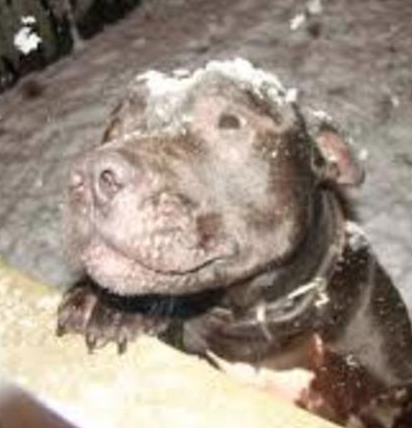The headline reads: “Lennox is destroyed,” and my writer’s mind thinks, what a perfect word. Destroyed — and its noun form, destruction — implies violence. Even recklessness. Lennox was undeniably destroyed. And along with him, our last hope for compassion and justice.
The Belfast City Council, who ordered Lennox dead based on the shape of his eyes and size of his head, proved as immune to human reason as any force of nature. Like an earthquake or massive hurricane, it couldn’t be swayed by evidence or history. International petitions and celebrity appeals were useless. Not even the teary face of a broken-hearted little girl could move that Belfast mountain.
The only thing more unforgivable than the Council’s decision to destroy Lennox is the suffering they put him through. Torn suddenly from the family he loved, Lennox spent two years frightened and wholly alone in a small cement cell. Reports of malnutrition and a broken leg are among the stories that have surfaced in the last few months. The idea this was going on in a supposedly civilized society was hard for so many to grasp.
And so it was pointed out that in this country, every day, thousands of innocent companion animals are also put to death. But Lennox’s story captured our attention and ignited our indignation in large part because of what he was forced to endure. Two years of neglect and loneliness. And hunger and fear and pain.
In the U.S., many of our shelters take great care to make an animal’s stay as stress-free as possible. In some parts of this country, though, the conditions are just as unimaginable, and the stays nearly as long, as Lennox’s. I’ve been lucky that the facilities I’ve worked in have been among the best. Still, it’s not unusual to see a dog shivering in fear in the corner of his kennel.
Whether in a cement cell in Ireland or a temperature-controlled kennel at a suburban SPCA, the dog only knows he is no longer in a familiar place with people he can trust. Everyone is a stranger and no explanation for the circumstances is available.
Some may bristle at the comparison (humans and animals are not equal! they’d say), but I can’t help think of the Innocence Project — the organization dedicated to exonerating wrongly accused death row prisoners. The other day on the radio I heard a man, recently freed, speaking about his 18 years behind bars, most in a hellish solitary confinement. DNA evidence finally cleared him of any wrongdoing whatsoever, but his sentence must have seemed unsurvivable at times. At least, and I recognize it’s small consolation, he knew there were people on the outside working to free him.
I always wonder what a dog is thinking when he’s led from his kennel to that room at the back of the shelter that smells of chemicals and metal. I look in his eyes and try to find a flicker of recognition of what’s to come. And I wonder, when Lennox was led from his cell that last time, whether there was any sense of hope. Maybe it’s anthropomorphic to suggest it, but if there was a spark of optimism, I can’t bear to think it was replaced by an awareness of his fate in his final moments.
This was not euthanasia. Lennox wasn’t destroyed because there was no place for him to go nor any family to love him. His behavior wasn’t aggressive. He was no danger to those around him. Lennox was destroyed out of pride, perhaps even malice, by a governing body unwilling to admit they’d misjudged an innocent individual. And as support for the dog grew, the Council dug in its heels, not even budging to let the family say goodbye.
So now what? How can we channel our emotion into something productive? If you’re reading this — and you’re outraged or grief-stricken or both — you’ve already taken the first step. You recognize that pain is not specific to any one species, that humans are not the only animals to suffer.
I say that the next step, and it’s a big one, is to make animal cruelty as unacceptable as human slavery, as morally repugnant as rape and murder. That could mean calling your senator about strengthening state laws or talking to your neighbor about her dog on a chain. The fights for social justice, both today and in ages past, are relevant to this cause — even if the species we’re fighting for does not walk upright. The similarities in each struggle are so much more striking than the differences.
In the meantime, do something tangible. Go to your shelter today, visit one dog. I’m not one who finds comfort in the idea of the Rainbow Bridge — I believe this time on Earth is all we get. But I do know that spending the afternoon with an animal who is scared and confused is about as close as I get to spirituality. If you’re more evolved than I am that way, share that godliness with an animal in need — perhaps a square-headed dog, alone in a kennel at your local shelter. Let him know he is not forgotten. Tell him Lennox sent you. And maybe somewhere, somehow, the brave dog from Northern Ireland will know what you did on his behalf.









